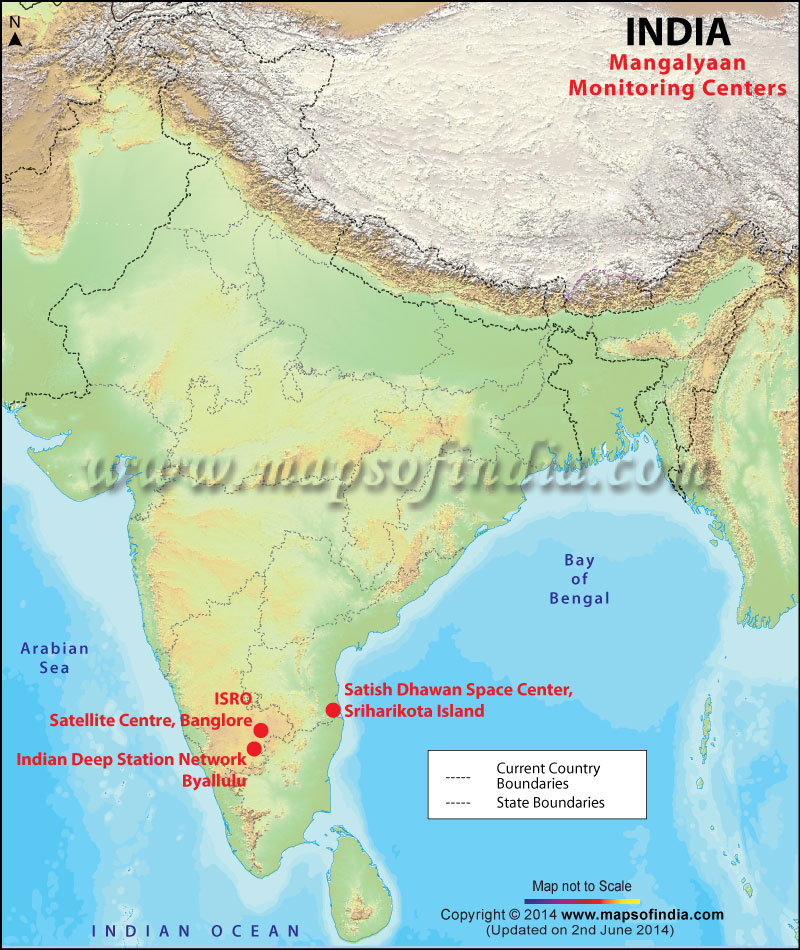 |
| Mangalyaan Infographic |
The U.S. based National Space Society (NSS), an independent non-profit educational membership organisation, has conferred 2015 Space Pioneer Award in the science and engineering category to India's Mars Orbiter programme team, as per the NSS society. In a statement issued by it in Washington on Monday, 12 January 2015, it said, "This award will be presented to an ISRO representative during the National Space Society's 2015 International Space Development Conference, the 34th ISDC, to be held in Toronto, Canada". The conference is scheduled for May 20-24.
According to the NSS, India's Mars Orbiter programme achieved two milestones, first being the foremost Indian spacecraft to have gone into Mars orbit in its initial attempt, which no other country has done before. Secondly, the spacecraft, with a high resolution camera was able to click full-disk colour images of Mars -- a rare feat, indeed. Also, the spacecraft is in an elliptical orbit with a high apoapsis.
The Mars Orbiter Spacecraft was launched on 5 November 2013 and it went into Mars orbit on 24 September 2014. Mylswamy Annadurai heads the Mars Orbiter programme team located in Bengaluru.
India's Mars Mission: A Giant Technological Leap
Let's have a look at India's successful Mars Mission:
- India's ambitious mission to Mars (Mangalyaan) took off at 2:38 pm on 5 November 2013.
- The rocket PSLV-C25 took off from the ISRO space centre at Sriharikota.
- The satellite weighed 1,350 kg approximately and 500 scientists worked on the project at Bengaluru.
India's ambitious Rs. 450-crore, robotic Mars Orbiter Mission (MoM) carrying Mangalyaan satellite, took off from the Satish Dhawan Space Centre, Sriharikota at 2:38 pm on 5 November 2013. During its launch, it was speculated that if it successfully reached Mars, it would indeed be a landmark achievement for both India and its iconic space agency, the Indian Space Research Organisation (ISRO).
The mission primarily constituted the launching of India's unmanned, 300-day, first inter-planetary satellite to Mars. The ISRO had already revealed its preparedness with a rehearsal held on October 31 for a smooth launch.
India's Daring Venture
The successful execution of the MoM has made India the fourth nation in the world to do so, after the U.S. - National Aeronautics and Space Administration (NASA), European consortium - European Space Agency (ESA), and Russia - Roscosmos had led their respective missions. Until its launch, only 21 of the 51 missions by various countries had been successful. Russia's last mission carrying a Chinese satellite had failed in November 2011. Thus, there was a great excitement to see India become the first Asian nation to achieve this feat.
The near 45-meter rocket PSLV-C25 carrying the 1,350 kg satellite was mounted on the pedestal and kept in a state of readiness (in a record 15 months) to blast off. The movements were tracked by vehicle tracking stations at Port Blair and Byalalu near Bengaluru and an outstation at Brunei. The terminals-on-sea lodged aboard the ships SCI Nalanda and SCI Yamuna, belonging to the Shipping Corporation of India helped to track and capture the precise moments of satellite injection into the earth's orbit. This process took approximately 40 minutes.
Thereafter, the satellite went around the earth for 20-25 days before making an exit for Mars on a nine-month journey. Five important scientific instruments such as photometer, methane sensor, mars composition analyser, and others were in place in the payload along with the satellite. These were meant to help navigate, monitor and capture information on Mars temperature, surface, colour composition, water loss, methane composition, etc.
As per ISRO, the main objective of the MoM was technological in nature - that is, to develop the technologies required for design, planning, management and operations of the interplanetary mission. NASA coordinated and provided support for its communication requirements.
This satellite thus became a part of the bouquet of India's operational satellites, which account for the largest network globally. About 500-1.000 scientists worked and checked out the overall specifics of the mission.
Fame, but Flak too
Earlier, India had faced strong disapproval, when it announced its decision to go ahead with the Mars mission in August 2012. Things such as "wasteful expenditure", "instead, money could be utilized to build toilets", etc., were being said.
However, after its successful Chandrayaan mission, India had profitably mastered the art of putting up satellites, as was seen last on 28 April 2008, at the success of the PSLV-C9 operation, when it had sent ten satellites belonging to different countries together in one go. Hence, this was an opportune time to showcase India's development in the field of space technology.
Mars Mission Underwent Successful First Course-Correction
India's first mission to the Red Planet, Mangalyaan, successfully finished its first mid-course correction on 11 December 2013 at 6:30 in the morning. "The mid-course correction was done some 2.9 million km away from Earth. The spacecraft was first re-oriented and then its smaller rockets fired to make the operation successful", an official of the ISRO had quoted.
After traversing an uncharted territory of Mars orbit, the spacecraft - Mangalyaan - has become the first Indian spacecraft to travel so far. The ISRO successfully accomplished this prestigious project, when the spacecraft was at a distance of 2.9 million km from Earth. The projected date for the spacecraft to enter into Mars orbit was 24 September 2014.
When Mission Completed 100 days
The first interplanetary mission of India to Mars completed one-third of its journey on 13 February 2014. In the 100 days from the day of launch, the orbiter travelled a distance of 190 million km. By the end of the journey, orbiter travelled more than 680 million km.
After the 100-day completion of the mission, an official of ISRO had revealed, "The spacecraft's health is normal. The spacecraft is continuously monitored by the ground station of ISRO Telemetry, Tracking and Command Network (ISTRAC), located at Byalalu, near Bengaluru. Except for a 40-minute break in the Telemetry data received from the spacecraft to the ground station, data has been continuously available for all the 100 days".
The spacecraft followed the trajectory all this while faithfully.
class="content_headingmid">The Countdown-When and What
| WHEN | IST | WHAT? |
|---|---|---|
| 1. T-3 hours | 04:17:32 AM | Changed over to Medium-Gain Antenna |
| 2. T-21 minutes | 06:56:32 AM | Forward Rotation started |
| 3 T-5 minutes 13 seconds | 07:12:19 AM | Eclipse started |
| 4. T-3 minutes | 07:14:32 AM | Attitude controlled with thrusters |
| 5. T | 07:17:32 AM | Liquid engine burn started |
| 6. T+ 4.3 minutes | 07:21:50 AM | Mars occult started |
| 7. T+ 5 minutes | 07:22:32 AM | Telemetry off |
| 8. T+12.5 minutes | 07:30:02 AM | Confirmation of burn started |
| 9. T+19.48 minutes | 07:37:01 AM | Eclipse ended |
| 10. T+24.23 minutes | 07:41:46 AM | Liquid engine burn ended |
| 11. T+25.73 to T+ 47 min | 07:42:46 to 08:04:32 | Reverse maneuver started |
| 12. T+27.78 minutes | 07:45:10 AM | Occult ended |
| The D Day: September 24,2014 | ||
| 13. T+30.43 minutes | 07:47:46 AM | Telemetry resumed and Doppler measurement provided first information about total burn performance |
| 14. T+35.23 minutes | 07:52:46 AM | Reverse maneuver ended |
EBAKB150115
Last Updated on : December 05, 2025
|
|

